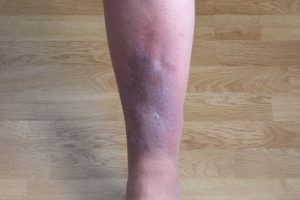How Venous Insufficiency Affects The Skin
Dr. Abella
Image: Stasis Dermatitis
Lipodermatosclerosis
Stasis Dermatitis
Other Names for Lipodermatosclerosis
Lipodermatosclerosis is also referred to by other medical terms, including sclerosing panniculitis and hypodermitis sclerodermiformis. These names may appear in medical records or literature, but they all describe the same skin change seen in the lower legs as a complication of venous insufficiency.
What is known is that factors such as obesity, increased pressure in the leg veins (venous hypertension), and malfunctioning or “leaky” vein valves (venous incompetence) can play a significant role in their development. These underlying issues contribute to poor blood flow, setting the stage for the skin changes and discomfort often seen with venous disease.
Who Gets Acute Lipodermatosclerosis?
Acute Lipodermatosclerosis tends to target individuals in middle age, with symptoms often appearing suddenly and without an obvious trigger like a recent injury or illness. Most commonly, you’ll see this form develop just above the inner ankle, where the skin becomes red, tender, and inflamed—an appearance that can easily be confused with cellulitis. This sudden inflammation is especially prevalent among those already managing chronic venous issues, making it important for anyone experiencing new and unexplained leg discomfort to consult with a healthcare provider.
Types of Lipodermatosclerosis
Lipodermatosclerosis doesn’t always look or feel the same for everyone—in fact, it typically falls into two main categories: acute and chronic.
Acute Lipodermatosclerosis often appears suddenly, without any obvious injury or illness to blame. Most often, it targets the inner area just above the ankle, creating a patch that’s red, scaly, and noticeably sore. This form is sometimes mistaken for cellulitis due to its inflammatory flair, and although anyone can be affected, it tends to crop up among middle-aged individuals.
Chronic Lipodermatosclerosis takes a slower, more subtle course. Its symptoms build over time and might include persistent pain, thickening or hardening of the skin, darker pigmentation, lingering swelling (edema), varicose veins, and in more advanced cases, open leg ulcers.
Recognizing which type is present can provide important clues about the best approach to managing venous insufficiency and its related skin changes.
